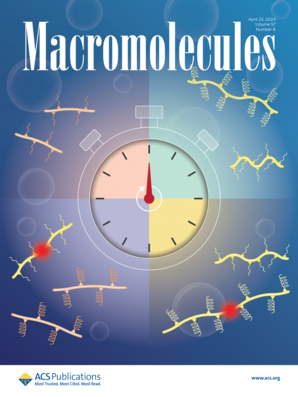Closer Look at the Substituent Effects on the Copolymerization of Thionolactones by Radical Ring-Opening Polymerization
IF 5.1
1区 化学
Q1 POLYMER SCIENCE
引用次数: 0
Abstract
The negative impact of plastic waste on the environment is a serious issue for the future. Adding cleavable bonds to the polymer backbone can help to impart degradability properties. To this end, radical ring-opening polymerization (rROP) offers a very attractive way to achieve radical copolymerization with vinyl monomers. Thionolactones, one of the various cyclic monomers that can be used in rROP, are promising structures due to the efficiency of the C═S bond in acting as a radical acceptor. In this work, we used DFT calculations to better understand the effects of different substituents on the radical reactivity of thionolactones (dibenzo[c,e]oxepane-5-thione DOT derivatives) already described as more or less effective for copolymerization with vinyl monomers in order to adjust the reactivity of these thionolactones. To carry out these calculations, we focused on the value of the transfer constant ktr and its relationship to the propagation constant kp of the vinyl monomer. The calculations performed subsequently on 7-phenyloxepane-2-thione (POT) derivatives highlighted that electron-donating groups inserted in the para-position on the phenyl ring should improve the copolymerization efficiency with acrylate derivatives, and in contrast, electron-withdrawing groups should lead to more important compositional drift during styrene and acrylate copolymerization. Although POT derivatives bearing electro-donating groups could not be prepared, the preparation of those with CF3 and NO2 groups was successfully achieved. Experimental copolymerization of these two thionolactones with styrene and isobornyl acrylate is in good agreement with the calculations. This result confirmed the versatility and relevance of our calculation approach to account for the reactivity of thionolactones.

基开环聚合中取代基对硫代内酯共聚反应的影响
塑料垃圾对环境的负面影响是未来的一个严重问题。在聚合物主链上加入可切割键有助于赋予其可降解性。为此,自由基开环聚合(rROP)提供了一种非常有吸引力的方法来实现乙烯基单体的自由基共聚。硫代内酯是可用于rROP的各种环状单体之一,由于C = S键作为自由基受体的效率,它是很有前途的结构。在这项工作中,我们使用DFT计算来更好地理解不同取代基对硫代内酯(二苯并[c,e]氧环-5-硫酮DOT衍生物)的自由基反应性的影响,这些取代基已经被描述为或多或少与乙烯基单体共聚有效,以便调整这些硫代内酯的反应性。为了进行这些计算,我们重点研究了乙烯基单体的传递常数ktr的值及其与传播常数kp的关系。随后对7-苯氧基-2-硫酮(POT)衍生物进行的计算表明,在苯基环上插入对位的给电子基团可以提高与丙烯酸酯衍生物的共聚效率,相反,在苯乙烯和丙烯酸酯共聚过程中,吸电子基团会导致更重要的组分漂移。虽然不能制备出含给电基团的POT衍生物,但成功制备了含CF3和NO2基团的POT衍生物。这两种硫代内酯与苯乙烯和丙烯酸异硼酸酯的共聚实验结果与计算结果吻合较好。这一结果证实了我们的计算方法的通用性和相关性,以说明硫代内酯的反应性。
本文章由计算机程序翻译,如有差异,请以英文原文为准。
求助全文
约1分钟内获得全文
求助全文
来源期刊

Macromolecules
工程技术-高分子科学
CiteScore
9.30
自引率
16.40%
发文量
942
审稿时长
2 months
期刊介绍:
Macromolecules publishes original, fundamental, and impactful research on all aspects of polymer science. Topics of interest include synthesis (e.g., controlled polymerizations, polymerization catalysis, post polymerization modification, new monomer structures and polymer architectures, and polymerization mechanisms/kinetics analysis); phase behavior, thermodynamics, dynamic, and ordering/disordering phenomena (e.g., self-assembly, gelation, crystallization, solution/melt/solid-state characteristics); structure and properties (e.g., mechanical and rheological properties, surface/interfacial characteristics, electronic and transport properties); new state of the art characterization (e.g., spectroscopy, scattering, microscopy, rheology), simulation (e.g., Monte Carlo, molecular dynamics, multi-scale/coarse-grained modeling), and theoretical methods. Renewable/sustainable polymers, polymer networks, responsive polymers, electro-, magneto- and opto-active macromolecules, inorganic polymers, charge-transporting polymers (ion-containing, semiconducting, and conducting), nanostructured polymers, and polymer composites are also of interest. Typical papers published in Macromolecules showcase important and innovative concepts, experimental methods/observations, and theoretical/computational approaches that demonstrate a fundamental advance in the understanding of polymers.
 求助内容:
求助内容: 应助结果提醒方式:
应助结果提醒方式:


